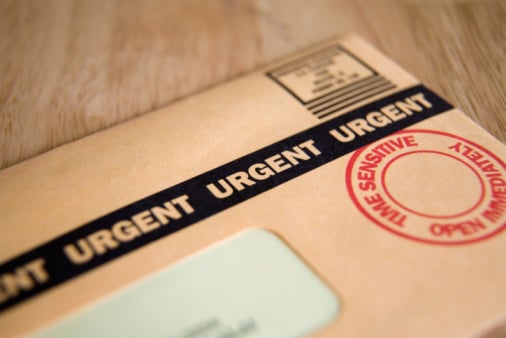 Let’s rip the Band-Aid off right away: Direct mail's a pain in the butt. Outside of a brand sponsoring a blimp and driving it straight through your kitchen window, there are few forms of marketing more disruptive and less welcome in one’s day.
Let’s rip the Band-Aid off right away: Direct mail's a pain in the butt. Outside of a brand sponsoring a blimp and driving it straight through your kitchen window, there are few forms of marketing more disruptive and less welcome in one’s day.
While we’re thankful to see companies figure outwhat makes a great marketing email, we still couldn’t resist exploring direct mail’s tactics and how they compare to successful inbound marketing campaigns.
Email Marketing vs. Direct Mail
As someone in the marketing world, when I get a new direct mail offer, I just stare in awe. I’m consistently amazed at the fact that someone, somewhere authorized (and paid for!) this to be sent. Why does the copy seem to be written by a hacky salesman on 12 Red Bulls? Why was this printed on paper that looks slightly oily? And, worst of all, why did the envelope tell me to open it for "important information concerning your account" before selling me on a new credit card?
Honestly, don’t more people now hate the brand because they received this?
Now, it’s no secret that early attempts at email marketing, with its blast-happy approach, were pretty similar to its offline cousin. But today, as the 2013 National DMA email report states, 89% of marketers consider email important to achieving their business goals. This continued emphasis is thanks in large part to marketers turning email into a “pull” channel that sends helpful, personalized content, versus a “push” channel that feels uncomfortable, forced, and spammy.
In fact, 1.9 billion non-spam emails are sent daily according to the Radicati Group, a technology market research firm. Now, some of these emails aren't top-notch ... I think we all get emails that seem like the equivalent of digital direct mail. But the very best of these emails contain consumer-friendly best practices, like clear calls-to-action, links to personalized content for download, and even unsubscribe options if you’d rather not receive emails again.
Direct mail? Not so much. If you didn’t ask for it, it doesn’t matter. It’s direct from them to you (and then, most likely, to your trash, or hopefully your recycling).
So, without further ado, here are some of direct mail’s most cringe-worthy tactics.
6 Terrible Direct Mail Tactics (and How Great Emails Differ)
1) Urgent, but Wildly Misleading, Subject Lines

Why This Is Terrible
If you guessed “blatantly violates my trust,” then congrats -- you’ve won! For your prize, we've got a torn up envelope for you -- it’s great for scribbling your next reminder or swatting flies, but really nothing else. Why? Because despite what the title in the image suggests, what’s actually inside this particular mailer is just a loud, colorful sales pitch for “saving big” and opening a new credit card. Having seen this even once, it’s easy to dislike and distrust every other send -- whether legitimate or sales-focused -- from this brand.
What a Five-Star Email Does
A five-star email uses a clear, accurate, and attention-grabbing email subject line. This subject line draws your interest by being explicit and transparent about what to expect inside the email. It does not deceive. Instead, it matches its contents to what it promised in the subject line or email header.
2) Cold, Impersonal, One-Size-Fits-All Look and Feel

Why This Is Terrible
The image shows an example of one the most common layouts (or lack thereof) with which we’re all too familiar. It just feels sneaky. What’s inside this? And who sent this to me? A trustworthy brand trying to help me with educational materials, a local company offering a new product I’d like, or someone with scraggly facial hair from a dimly lit basement?
My initial reaction to the envelope is skepticism. If they did marketing right, they’d be proud and transparent about it -- not hiding their intentions.
What a Five-Star Email Does
Emails in general are sent from someone, while stellar emails are often sent from a real person’s name, not just a company name (though you should A/B test performance using both versions to see what works for your audience specifically). This form of upfront identification, in addition to clear branding, are two common elements of five-star email marketing that are so accepted by everyone in the industry, they seem too basic to even highlight here.
3) So Irrelevant It’s Actually Funny

Why This Is Terrible
We’ve all experienced this type of direct mail. It’s the kind that you pick up and go, “Huh?” It’s so radically off in targeting you with the right product, service, or content that you can't believe it has your name on it.
Take this flyer for instance -- it advertises a free consultation at a university’s orthodontic patient treatment center. My wife currently pursues her Ph.D. at the same school, but that’s where the relevancy falls off a cliff. Not only does she have perfect teeth, but she’s also already had dental work done in the past. So she has no need for this service, making the flyer utterly useless. Had they possessed any context on her at all, the university’s marketers would never have sent it in the first place.
What a Five-Star Email Does
Successful inbound marketing emails will target the right person with the right message at the right time. Most email technology today, including ours, pulls from some kind of database to help you segment your lists and send different emails for different groups of people based on tons of factors, all in the name of personalization and relevancy. This helps you customize your sender name, subject line, email contents, various links and calls-to-action inside, and more. Five-star emails do so much more than direct mail to treat you like, well, you.
4) Value Propositions Straight Out of Cheap Infomercials


Why This Is Terrible
These two examples are presented loudly and proudly in their respective mailers ostensibly to tell me why I should be excited about the companies' products. But let’s break them down to highlight why they’re truly terrible, and yet, at the same time, oh-so-amazing.
First, “Money Back Guarantee” as a core value proposition under “Your Benefits” immediately lets negative thoughts creep in. Perhaps more alarming, however, is that this money-back claim was made louder and bolder than the potential 72% savings. The company is essentially marketing to me backwards: Instead of highlighting that I can pay just one-fourth the cover price and get crazy savings, they’re telling me, "Hey, if you hate our stuff or make a mistake purchasing, no big deal, we'll pay you back." How is any of this building my trust and converting me to a customer?
In the other example, “Real Savings” is the lone copy that stood out above the fold inside the letter. I have to ask: Why is the word "real" underscored? Should I be concerned about fake savings? Are you correcting a previous error in which you sent some false savings before? Again, marketers must build trust, not doubt.
What a Five-Star Email Does
A five-star email keeps value proposition statements simple and transparent to build that trust -- in the subject line and the body copy, the value contained in the email is overtly stated. It immediately addresses why something is relevant to you and either helps solve a problem or offers something you actually want at that moment in time. In short, great email value statements are clear and useful, not uncomfortable or sleazy.
5) The "Where’s Waldo?" of Calls-to-Action

Why This Is Terrible
Hypothetically, let's say you like what the letter above has to say and want to act right now -- only you’re left to hunt the page for how to proceed. This letter, for example, asked me to buy a magazine subscription. But they're asking too much of their audience to find the core call-to-action and best way to become a customer. The average attention span of a consumer today is somewhere around 8-9 seconds. The harder it is for anyone to find that call-to-action, the worse the conversion rate will be.
Looking at the picture above, give yourself a few seconds and try to find the call-to-action. Try the squint test to see if the main action stands out. Did you find it? Give up?
It's right here:

That's right -- the most important thing this company wanted me to do (subscribe) is written in small black font, tucked to the margin under a counterintuitive header reading, “SEND NO MONEY NOW.” Meanwhile the loudest, clearest copy adds no value ("Professional Benefits Form") while the boldest colors don't tell me how to buy. Truly mind-boggling, right?
What a Five-Star Email Does
You’re sensing a trend by now, of course -- a great email (heck, even a normal one) does a much better job placing an obvious, focused call-to-action inside. When someone wants to act, they make it as easy as possible to do just that. The very best emails will place the call-to-action button above the fold (i.e. above the point where a reader needs to scroll down), right next to the clear value proposition we talked about earlier, all with minimal, command-focused copy like, “Download my ebook now.”
6) In the end, the scary realization is they have the control.
Why This Is Terrible
Here’s a somewhat frightening thought: How do you unsubscribe to junk mail? You didn’t ask for this, so why did you receive it, and how do you make it stop?
Thankfully, for those who feel spammed today, we have Google, and a quick search reveals some numbers to call and forms to fill out to remove yourself from various listings and organizations' attempts to stuff your mailbox. But at no point are these direct mailers letting you know how to opt out in the actual letters.
What a Five-Star Email Does
Unsubscribe links are actually a mandatory part of all email marketing. Sending an email without an unsubscribe option violates CAN-SPAM regulations, can significantly damage your email sender credibility, and can even potentially leave your marketing open to costly fees or litigation. A five-star email makes the unsubscribe process straightforward and easy.
Another five-star approach is to turn the unsubscribe process into a positive. On the page, you can place a funny video, a photo of your staff looking sad, a few alternatives to connect with your company aside from email (like social), or even just write a friendly bit of copy on your unsubscribe page. They’re leaving -- don’t force them to stay. But do let them know your intentions are good and you’d love to help if a need arises in the future.
At its core, great marketing is all about treating people like people, regardless of the channel, tactic, or technology. Help your prospects and customers by providing useful content and personalized messages that feel like they’re from another person. Email does this well today, and if direct mail can someday achieve this, then that’s a better world to live in.
Dissecting a Five-Star Email
The elements of a five-star email mentioned above were pulled from a popular HubSpot ebook. In the guide, we dive more deeply into the aspects of a great email that you can build around to increase open rates, click-through rates, and conversions. We also include a printable checklist to keep handy. Download those materials here.




![The Best Time to Send an Email [2023 Research]](https://53.fs1.hubspotusercontent-na1.net/hubfs/53/best-time-to-send-an-email.png)



